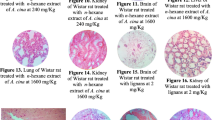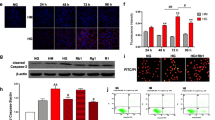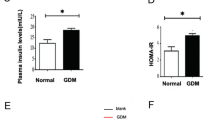Abstract
Aim:
The aim of this study was to investigate whether Gs-Rbl relieves the CoCl2-induced apoptosis of hypoxic neonatal rat cardiomyocytes and in which the role of glucose transporter-4 (GLUT-4).
Methods:
Gs-Rbl (0, 10, 50, 100, 200, 400, and 500 μmol/L), adenine 9-β-D-arabinofuranoside (ara A, 500 μmol/L; AMPK inhibitor) and wortmannin (0.5 μmol/L; PI3K inhibitor) only in combination with 200 μmol/L Gs-Rbl were administered in hypoxic cardiomyocytes, which were induced by 500 μmol/L CoCl2 for 12 h. Then, the apoptotic rate (AR), 2-[3H]-deoxy-D-glucose (2-[3H]-DG) uptake, and the expression of GLUT-4 (including in plasma membrane, PM), phospho-AMPKα (Thr172), AMPKα and Akt in cells were assayed.
Results:
Compared with simple hypoxia (0 μmol/L Gs-Rbl), Gs-Rb1 greater than 10 μmol/L significantly decreased the apoptotic rate (P<0.01) and significantly increased 2-[3H]-DG uptake (P<0.01), GLUT-4 content in cells and PM (P<0.01), AMPK activity (P<0.01) and Akt (P<0.01) levels in a dose-dependent manner. AMPK activity was completely suppressed by ara-A, just as Akt was suppressed by wortmannin. The AR, glucose uptake and GLUT-4 levels in cells and PM were partly down-regulated by ara-A or wortmannin.
Conclusion:
Gs-Rb1 may protect neonatal rat cardiomyocytes from apoptosis induced by CoCl2. The anti-apoptotic effect of Gs-Rb1 may occur by improving glucose uptake, in which GLUT-4 translocation and expression played a key role. Both the AMPK and the PI3K/Akt pathways may take part in the anti-hypoxic efficacy of Gs-Rb1.
Similar content being viewed by others
Log in or create a free account to read this content
Gain free access to this article, as well as selected content from this journal and more on nature.com
or
References
Rahimtoola SH . The hibernating myocardium. Am Heart J 1989; 117: 211–21.
Ausma J, Thoné F, Dispersyn GD, Flameng W, Vanoverschelde JL, Ramaekers FC, et al. Dedifferentiated cardiomyocytes from chronic hibernating myocardium are ischemia-tolerant. Mol Cell Biochem 1998; 186: 159–68.
Freude B, Masters TN, Kostin S, Robicsek F, Schaper J . Cardiomyocyte apoptosis in acute and chronic conditions. Basic Res Cardiol 1998; 93: 85–9.
Dispersyn GD, Ausma J, Thoné F, Flameng W, Vanoverschelde JL, Allessie MA, et al. Cardiomyocyte remodelling during myocardial hibernation and atrial fibrillation: prelude to apoptosis. Cardiovasc Res 1999; 43: 947–57.
Thomas SA, Fallavollita JA, Suzuki G, Borgers M, Canty JM Jr . Dissociation of regional adaptations to ischemia and global myolysis in an accelerated swine model of chronic hibernating myocardium. Circ Res 2002; 91: 970–7.
Ausma J, Wijffels M, van Eys G, Koide M, Ramaekers F, Allessie M, et al. Dedifferentiation of atrial cardiomyocytes as a result of chronic atrial fibrillation. Am J Pathol 1997; 151: 985–97.
Czech MP, Corvera S . Signaling mechanisms that regulate glucose transport. J Biol Chem 1999; 274: 1865–8.
Burant CF, Sivitz WI, Fukumoto H, Kayano T, Nagamatsu S, Seino S, et al. Mammalian glucose transporters: structure and molecular regulation. Recent Prog Horm Res 1991; 47: 349–87.
Chen J, Hudson E, Chi MM, Chang AS, Moley KH, Hardie DG, et al. AMPK regulation of mouse oocyte meiotic resumption in vitro. Dev Biol 2006; 291: 227–38.
Beeson M, Sajan MP, Dizon M, Grebenev D, Gomez-Daspet J, Miura A, et al. Activation of protein kinase C-zeta by insulin and phosphatidylinositol-3,4,5-(PO4)3 is defective in muscle in type 2 diabetes and impaired glucose tolerance: amelioration by rosiglitazone and exercise. Diabetes 2003; 52: 1926–34.
Xing Y, Musi N, Fujii N, Zou L, Luptak I, Hirshman MF, et al. Lucose metabolism and energy homeostasis in mouse hearts overexpressing dominant negative alpha2 subunit of AMP-activated protein kinase. J Biol Chem 2003; 278: 28372–7.
Martin SS, Haruta T, Morris AJ, Klippel A, Williams LT, Olefsky JM . Activated phosphatidylinositol 3-kinase is sufficient to mediate actin rearrangement and GLUT4 translocation in 3T3-L1 adipocytes. J Biol Chem 1996; 271: 17605–8.
Fischer Y, Kamp J, Thomas J, Pöpping S, Rose H, Carpéné C, et al. Signals mediating stimulation of cardiomyocyte glucose transport by the alpha-adrenergic agonist phenylephrine. Am J Physiol 1996; 270 (4 Pt 1): C1211–20.
Liu YF, Liu SW, Liu ZX . Effects of ginsenoside Rb1 on blood vessel regeneration after ischemia and reperfusion in rats. Chin J Histochem Cytochem 2008; 17: 39–44.
Zeng HS, Liu ZX . Influence of ginsenoside Re on cardiomyocyte apoptosis and Fas expression after acute ischemia-reperfusion in rats. J Huazhong Univ Sci Tech [Health Sci] 2004; 33: 286–8.
Guan L, Li WZ, Liu ZX . Effect of ginsenoside-Rbl on cardiomyocyte apoptosis after ischemia and reperfusion in rats. J Huazhong Univ Sci Tech[Med Sci] 2002; 22: 212–5.
Kakinuma Y, Miyauchi T, Yuki K, Murakoshi N, Goto K, Yamaguchi I . Mitochondrial dysfunction of cardiomyocytes causing an impairment of cellular energy metabolism induces apoptosis, which is accompanied by an increase in cardiac ET-1 expression. J Cardiovasc Pharmacol 2000; 36: S201–4.
James DE, Piper RC . Insulin resistance, diabetes, and the insulin-regulated trafficking of GLUT-4. J Cell Biol 1994; 126: 1123–6.
Sun D, Nguyen N, DeGrado TR, Schwaiger M, Brosius FC 3rd . Ischemia induces translocation of the insulin-responsive glucose transporter GLUT4 to the plasma membrane of cardiac myocytes. Circulation 1994; 89: 793–8.
Young LH, Renfu Y, Russell R, Hu X, Caplan M, Ren J, et al. Low-flow ischemia leads to translocation of canine heart GLUT-4 and GLUT-1 glucose transporters to the sarcolemma in vivo. Circulation 1997; 95: 415–22.
Coven DL, Hu X, Cong L, Bergeron R, Shulman GI, Hardie DG, et al. Physiological role of AMP-activated protein kinase in the heart: graded activation during exercise. Am J Physiol Endocrinol Metab 2003; 285: E629–36.
Fischer Y, Thomas J, Sevilla L, Muñoz P, Becker C, Holman G, et al. Insulin-induced recruitment of glucose transporter 4 (GLUT4) and GLUT1 in isolated rat cardiac myocytes. Evidence of the existence of different intracellular GLUT4 vesicle populations. J Biol Chem 1997; 272: 7085–92.
Gertz EW, Wisneski JA, Stanley WC, Neese RA . Myocardial substrate utilization during exercise in humans. Dual carbon-labeled carbohydrate isotope experiments. J Clin Invest 1988; 82: 2017–25.
Cushman SW, Wardzala LJ . Potential mechanism of insulin action on glucose transport in the isolated rat adipose cell. Apparent translocation of intracellular transport systems to the plasma membrane. J Biol Chem 1980; 255: 4758–62.
Suzuki K, Kono T . Evidence that insulin causes translocation of glucose transport activity to the plasma membrane from an intracellular storage site. Proc Natl Acad Sci USA 1980; 77: 2542–5.
Opie LH, Sack MN . Metabolic plasticity and the promotion of cardiac protection in ischemia and ischemic preconditioning. J Mol Cell Cardiol 2002; 34: 1077–89.
Tian R, Abel ED . Responses of GLUT4-deficient hearts to ischemia underscore the importance of glycolysis. Circulation 2001; 103: 2961–6.
Buhl ES, Jessen N, Schmitz O, Pedersen SB, Pedersen O, Holman GD, et al. Chronic treatment with 5-aminoimidazole-4-carboxamide-1-beta-D-ribofuranoside increases insulin-stimulated glucose uptake and GLUT4 translocation in rat skeletal muscles in a fiber type-specific manner. Diabetes 2001; 50: 12–7.
Jessen N, Pold R, Buhl ES, Jensen LS, Schmitz O, Lund S . Effects of AICAR and exercise on insulin-stimulated glucose uptake, signaling, and GLUT-4 content in rat muscles. J Appl Physiol 2003; 94: 1373–9.
Jørgensen SB, Treebak JT, Viollet B, Schjerling P, Vaulont S, Wojtaszewski JF, et al. Role of AMPKalpha2 in basal, training-, and AICAR-induced GLUT4, hexokinase II, and mitochondrial protein expression in mouse muscle. Am J Physiol Endocrinol Metab 2007; 292: E331–9.
Suwa M, Egashira T, Nakano H, Sasaki H, Kumagai S . Metformin increases the PGC-1alpha protein and oxidative enzyme activities possibly via AMPK phosphorylation in skeletal muscle in vivo. J Appl Physiol 2006; 101: 1685–92.
Ojuka EO, Nolte LA, Holloszy JO . Increased expression of GLUT-4 and hexokinase in rat epitrochlearis muscles exposed to AICAR in vitro. J Appl Physiol 2000; 88: 1072–5.
Holmes BF, Sparling DP, Olson AL, Winder WW, Dohm GL . Regulation of muscle GLUT4 enhancer factor and myocyte enhancer factor 2 by AMP-activated protein kinase. Am J Physiol Endocrinol Metab 2005; 289: E1071–6.
Fryer LG, Foufelle F, Barnes K, Baldwin SA, Woods A, Carling D . Characterization of the role of the AMP-activated protein kinase in the stimulation of glucose transport in skeletal muscle cells. Biochem J 2002; 363: 167–74.
Guan F, Yu B, Qi GX, Hu J, Zeng DY, Luo J . Chemical hypoxia-induced glucose transporter-4 translocation in neonatal rat cardiomyocytes. Arch Med Res 2008; 39: 52–60.
Omar MA, Fraser H, Clanachan AS . Ischemia-induced activation of AMPK does not increase glucose uptake in glycogen-replete isolated working rat hearts. Am J Physiol Heart Circ Physiol 2008; 294: H1266–73.
Lawlor MA, Alessi DR . PKB/Akt: a key mediator of cell proliferation, survival and insulin responses? J Cell Sci 2001; 114: 2903–10.
Alessi DR, Downes CP . The role of PI3-kinase in insulin action. Biochim Biophys Acta 1998; 1436: 151–64.
Tanti JF, Grillo S, Grémeaux T, Coffer PJ, Van Obberghen E, Le Marchand-Brustel Y . Potential role of protein kinase B in glucose transporter 4 translocation in adipocytes. Endocrinology 1997; 138: 2005–10.
Kohn AD, Summers SA, Birnbaum MJ, Roth RA . Expression of a constitutively active Akt Ser/Thr kinase in 3T3-L1 adipocytes stimulates glucose uptake and glucose transporter 4 translocation. J Biol Chem 1996; 271: 31372–8.
Lam K, Carpenter CL, Ruderman NB, Friel JC, Kelly KL . The phosphatidylinositol 3-kinase serine kinase phosphorylates IRS-1. Stimulation by insulin and inhibition by wortmannin. J Biol Chem 1994; 269: 20648–52.
Tanti JF, Grémeaux T, Van Obberghen E, Le Marchand-Brustel Y . Insulin receptor substrate 1 is phosphorylated by the serine kinase activity of phosphatidylinositol 3-kinase. Biochem J 1994; 304 (Pt 1): 17–21.
Maulik N, Yoshida T, Das DK . Regulation of cardiomyocyte apoptosis in ischemic reperfused mouse heart by glutathione peroxidase. Mol Cell Biochem 1999; 196: 13–21.
Nakamura K, Bossy-Wetzel E, Burns K, Fadel MP, Lozyk M, Goping IS, et al. Changes in endoplasmic reticulum luminal environment affect cell sensitivity to apoptosis. J Cell Biol 2000; 150: 731–40.
Acknowledgements
We thank Prof Hai-peng ZHANG (Department of Pathophysiology, China Medical University) for providing reagents.
Author information
Authors and Affiliations
Corresponding author
Rights and permissions
About this article
Cite this article
Kong, Hl., Wang, Jp., Li, Zq. et al. Anti-hypoxic effect of ginsenoside Rbl on neonatal rat cardiomyocytes is mediated through the specific activation of glucose transporter-4 ex vivo. Acta Pharmacol Sin 30, 396–403 (2009). https://doi.org/10.1038/aps.2009.2
Received:
Accepted:
Published:
Issue date:
DOI: https://doi.org/10.1038/aps.2009.2
Keywords
This article is cited by
-
Ginsenoside Rb1 exerts antiarrhythmic effects by inhibiting INa and ICaL in rabbit ventricular myocytes
Scientific Reports (2019)
-
Ginsenoside Rb1 Ameliorates Autophagy of Hypoxia Cardiomyocytes from Neonatal Rats via AMP-Activated Protein Kinase Pathway
Chinese Journal of Integrative Medicine (2019)
-
Apelin-APJ effects of ginsenoside-Rb1 depending on hypoxia-induced factor 1α in hypoxia neonatal cardiomyocytes
Chinese Journal of Integrative Medicine (2015)
-
Roles and mechanisms of ginseng in protecting heart
Chinese Journal of Integrative Medicine (2012)
-
Ginsenoside Rb1 protects cardiomyocytes against CoCl2-induced apoptosis in neonatal rats by inhibiting mitochondria permeability transition pore opening
Acta Pharmacologica Sinica (2010)



